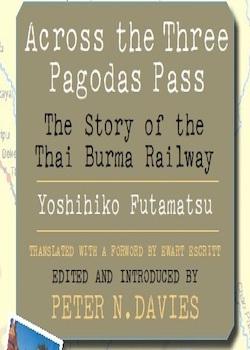Across the Three Pagodas Pass: The Story of the Thai-Burma Railway

By Yoshihiko Futamatsu
Translated and Introduced by Ewart Escritt
Edited and with a Foreword by Peter N Davies
Renaissance Books, 2013, lxiv 239 pages
ISBN 978-1-898823-07-0
Review by Ian Nish
Yoshihiko Futamatsu was a professional engineer trained at Kyoto University. In wartime he became a gunzoku, a civilian member of an army bridging unit involved in the attack on Singapore. He says that, because of the operations of British submarines in the Andaman Sea, the Japanese did not have a secure maritime supply route to Burma for their campaign there in 1942. Instead they adopted a plan for a land route by building a railway from Thailand to Burma which had been studied in Army GHQ since 1939. Futamatsu as an engineer with the rank of captain (later major) was switched from bridging to railway construction and joined the project in June 1942. Employment of POWs was apparently a military decision rather than one taken in Tokyo and had, the author states, been carefully thought out from the start. But the army had to revise its plans because of the unexpectedly large number of British and other allied soldiers captured in the fall of Singapore.
When the allies began a counteroffensive in north Burma at the beginning of 1943, Army GHQ ruled that the railway must be finished by the summer. This led to what Futamatsu calls ‘rushed construction’ (Kyusoku kensetsu); it was ‘a reckless command’ which led to imperfect standards of building. The line was opened to traffic in October 1943 when the soldiers of the 5th railway regiment working south from the Burma side with the help of local coolies joined up with the 9th railway regiment at the Three Pagodas Pass near the frontier station of Konkuita, hence the title of the book. But the operation of the line presented problems: the opening-to-traffic coincided with enemy air attacks. Japan had no fighters in the area; and her anti-aircraft guns were ineffective. In the following year the supply route was often interrupted by intensive allied bombing, especially of bridges. Thus, the engineering teams spent much time repairing the line. Futamatsu was understandably depressed at seeing the destruction of the railway so carefully planned and painstakingly constructed at such cost in human lives.
Futamatsu became a POW in Bangkok at the end of the war and successfully claimed early release as a non-combatant gunzoku. He was repatriated to Uraga on 27 June 1946. He resumed his career with Japanese National Railways and continued with consultancies as an engineer into the 1980s.
Primarily the book provides an account of his wartime experiences, a personal story of hardship, illness and disappointment over failed attempts at repatriation. He is proud of the Thai-Burma railway as an engineering achievement in a hostile environment. But he has criticisms of the route chosen and the faulty planning: it was never going to be able to carry enough supplies for the ambitious campaign being waged by the army in Burma. He is reticent about his beliefs over the treatment of POWS and other Asian railway builders. But he quotes at length from British authors who have written accounts of their treatment on the railway and comments sympathetically on them. He is critical of the film Bridge on the River Kwai along the lines that those like Louis Allen have pointed out. (1) Futamatsu had issued two pamphlets on the Thai-Burma railway around 1955 but, annoyed by the inaccuracies of the film and elsewhere, he published a comprehensive study on the subject in 1985 (in Japanese). It is this which is now translated.
It is not possible in a short review to examine his arguments in any detail. The author argues that, since Japan had not signed the Geneva convention on POWs, the Japanese military was entitled to decline responsibility for employing POWs. But the editor points out that Japan had signed and ratified the earlier Hague Convention. (p.51) Futamatsu repeats the familiar Japanese view that soldiers must not surrender but die, when captured. At the same time he acknowledges the great contribution which the prisoners and coolies made to the railway building. This is not a book devised specially for a western readership but the translation of something addressed in the first place to a Japanese public.
Futamatsu’s book is fluently translated from the Japanese by the late Ewart Escritt, himself a POW working in Thailand. Escritt also contributes a lengthy introduction containing partly a memoir of his own experiences on the railway and partly a critique of Futamatsu’s ideas (pp. xxvii-lviii). Since Escritt’s and Futamatsu’s deaths the project has been carried forward by Professor Peter N. Davies, Emeritus Professor of the University of Liverpool. In his foreword he explains the vicissitudes of seeing this project through despite the traumas of translation and publication. He claims that it gives the reader the opportunity of evaluating the non-western viewpoint on the infamous railway and reaching a balanced judgment on a highly controversial subject (p.xxii). The book is a good read and contains much interesting new information.
- see The Writings of Louis Allen : War, Conflict and Security in Japan and the Asia- Pacific, 1941-52, Folkestone, Global Oriental, 2011, ch. 7

